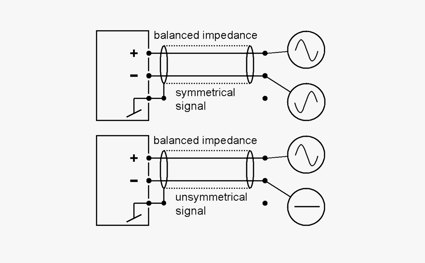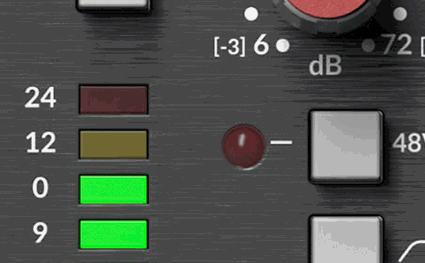Electromagnetic interference: EMC, RFI immunity and CMRR
This article describes the problems that arise from electromagnetically induced noise. It explains how to avoid the problems by utilizing balanced lines.

How to get rid of that hum?
When working with microphones it is important that only the acoustic sound at the microphone is transmitted. All kinds of noise from electromagnetic interference (EMI) should be avoided. This is easy to say. However, real life can make it very difficult to accomplish.
Bear in mind that whenever an electric current is driven through an electric conductor, an electromagnetic field is created around that conductor. Furthermore, whenever an electric conductor is placed in a varying electromagnetic field, an electric current is induced in that conductor.
What is EMC?
EMC is an abbreviation of Electro-Magnetic Compatibility. It is the term used to describe how well a device or a system is able to function in an electromagnetic environment without introducing electromagnetic disturbances that interfere with the operation of other electrical products in the environment.
Electronic devices – like microphones – that can function and meet the criteria are called electro-magnetically compatible devices.
What is RFI?
RFI is an abbreviation of Radio Frequency Interference. The RFI range is between audible frequencies (AF, Audio Frequency range) and the frequencies of infrared light. Many devices produce radio frequencies despite the fact that they are designed for audio frequencies (e.g. digital power amplifiers) or not for audio at all (like various light dampers). The occurrence of radio frequency is not necessarily related to intentional transmission of radio waves. RFI can be the reason for audible noise when passing un-linear electronic circuitry.
What does EMI/RFI sound like?
All audio engineers know the noise a roaming mobile phone can generate in different audio equipment. All electric guitarists know the humming sound induced in the coil of the guitar pickup. Sometimes even radio stations are picked up and detected. On stage the EMI/RFI can be generated by the lighting dimmers, depending on the design principles. Also wireless microphones may introduce broadband noise in the microphone signal.
EMC testing
All electronic products (including microphones) must undergo EMC testing before they are offered for sale to prove that they will not create interference, or be susceptible to interference from other devices. For testing purposes, products are grouped into two classes: intentional radiators and unintentional radiators. For example, mobile phones and wireless microphones intentionally radiate energy while mixers, amps, recorders or laptops should not.
Regarding the emission of a given product, the EMC requirements set the limits for amplitude and frequency that a product can radiate or conduct so that the device does not interfere with others.
Regarding susceptibility and immunity, the testing category complements the emissions requirement by limiting the amplitude and frequency of the radiated and conducted signals that can interfere with a product. Thus, in a perfect world, there would be no problems.
Microphones and EMC
Microphones almost never produce electro-magnetic fields that will cause interference. Some brands use RF modulation for the condenser microphones. However, the emission is in general negligible.
Rather, the key point is the level of susceptibility that can be obtained in the design from the diaphragm to the output connector. This is primarily related to the microphones’ transducer type, secondly to other issues like shielding and the design of the output stage.
Most sensible to EMI/RFI are ribbon microphones. The diaphragm itself is a conductor more or less working as an antenna that easily picks up electromagnetic fields. Other dynamic microphones have moving coil designs; the professional types are largely compensated by having a so-called noise coil: attached to the diaphragm, the coil moves inside the gap of a circular magnet and thus produces the output signal. A static coil is placed somewhere else in the microphone body. When an external electromagnetic field generates a voltage across the moving coil, an oppositely phased voltage is generated across the fixed coil. The result is that the two signals more or less cancel each other out while the signal from the movement of the diaphragm remains.
In general, condenser microphones are less sensitive to external electromagnetic fields. However, in the design process, care must be taken to optimize immunity just as bad soldering can cause a lot of RFI initiated noise problems.
CMRR – a question of balance
Common Mode Rejection Ratio (CMRR) expresses the suppression of induced EMI noise on the terminals of a device. This suppression is possible only if you use balanced lines. On the XLR connector pin 1 is for the shielding of the cable and should never carry the signal. Pins 2 and 3 carry the signal. It is important that the impedance measured from pin 2 to ground and from pin 3 to ground is exactly the same. This applies to both sending and receiving devices (for instance a microphone and the input of the mixer) as well as to the cable, the two signal carrying wires running between the XLR connectors’ two pin 2’s and the two pin 3’s. Also the soldering of the cable connectors must be the best possible to avoid a reduced sound quality of the circuitry as a whole. The weakest link determines the final result.
When the well balanced cable is running through an electromagnetic field the induced voltage has the same polarity and magnitude on both leads. As the input will only accept a signal if it is oppositely phased on pin 2 and pin 3, the noise from the electromagnetic field is rejected.
If the microphone is sound, the electronics are well designed, and the cable and receiving device are fairly balanced, there is a good chance of avoiding problems with EMI.
The suppression of the noise (the CMRR) of the MMP-A Microphone Preamplifier in the Recording Microphones Series is approximately 65 dB. This means that less than one thousandth of the noise will pass through the microphone circuitry.
How to avoid EMC problems?
First and foremost: check the specs of your equipment. The CMRR is important; a larger number equals better data. Make sure that your microphones meet the EMC requirements. Always use sound cables. Try to avoid placing your microphones or cables in positions where there they are in danger of being exposed to high EMI (close to power transformers, along lighting cables, power cables, speaker cables, etc.).



